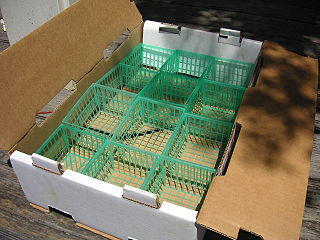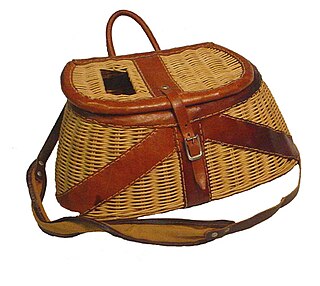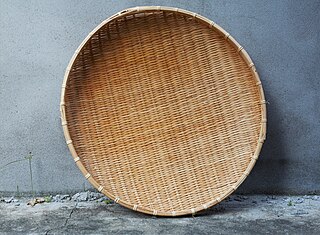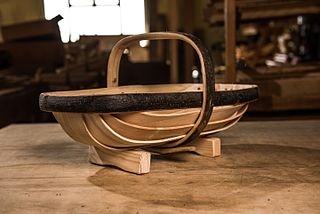 W
WA basket is a container that is traditionally constructed from stiff fibers and can be made from a range of materials, including wood splints, runners, and cane. While most baskets are made from plant materials, other materials such as horsehair, baleen, or metal wire can be used. Baskets are generally woven by hand. Some baskets are fitted with a lid, while others are left open on top.
 W
WBasket weaving is the process of weaving or sewing pliable materials into three-dimensional artifacts, such as baskets, mats, mesh bags or even furniture. Craftspeople and artists specialized in making baskets may be known as basket makers and basket weavers. Basket weaving is also a rural craft.
 W
WA punnet is a small box or square basket for the gathering, transport and sale of fruit and vegetables, typically for small berries susceptible to bruising, spoiling and squashing that are therefore best kept in small rigid containers. Punnets serve also as a rough measure for a quantity of irregular sized fruits.
 W
WAgaseke is a type of traditional Rwandese woven basket. It is characterized by its flat circular base that is taller than it is wide, with a sloped conical fitted lid. It is traditionally made of native natural fibers in natural off-white colors with naturally-dyed patterns in colors like purple, green, black, yellow, and red. There are numerous patterns that can be displayed on the sides of the agaseke, each with their own significance.
 W
WA calathus or kalathos was a basket in the form of a top hat, used to hold wool or fruit, often used in ancient Greek art as a symbol of abundance and fertility. These baskets were made by weaving together reeds or twigs. They were typically used by women to store skeins of wool, but they had other uses in the household. In Roman times, there are reports for baskets of these sorts to be used in agricultural activities like bringing in the fruits from the fields.
 W
WBamboo weaving is a form of bambooworking and a craft of China. It involves manipulating bamboo into various traditional knit and woven patterns to create both useful and decorative objects.
 W
WA creel is a wicker basket usually used for carrying fish or blocks of peat. It is also the cage used to catch lobsters and other crustaceans.
 W
WAn Easter basket is a special basket used in Easter celebrations. Easter baskets are typically filled with Easter eggs, food, toys, or other gifts depending on one's culture. As many people give up sweets as their Lenten sacrifice, individuals receive them in their Easter baskets after having abstained from them during the preceding forty days of Lent.
 W
WA fully feathered basket is a type of basket crafted by a select group of Indigenous people of California who have traditionally resided in the coastal region of Northern California above San Francisco. The baskets are distinguished by the matted layer of feathers, which completely cover the exterior of the basket. They are highly collectible and renowned for their fine craftsmanship.
 W
WBamboo weaving is a form of bambooworking and a traditional Japanese craft , with a range of different applications, weaving styles and appearances. Japanese bamboo weaving is particularly well known for its use in basket weaving.
 W
WKete are traditional baskets made and used by New Zealand's Māori people. They may be of many sizes, but are most often found in sizes similar to large handbags. Kete are traditionally woven from the leaves of New Zealand flax called harakeke and have two handles at the top. Other materials are sometimes used, including the leaves of the nikau palm and cabbage tree.
 W
WBasketry of Mexico has its origins far into the pre Hispanic period, pre-dating ceramics and the domestication of crops. By the time the Spanish arrived, there were a number of indigenous forms, a number of which are still made today. These and products that the Spanish introduced form the combined tradition that remains today. Like other Mexican handcrafts, sales to tourists and collectors is important, but basketry is not as popular as other handcrafts. Basketry techniques and materials vary from region to region depending on the vegetation available, with important traditions in Sonora, State of Mexico, Michoacán, Veracruz, Oaxaca and the Yucatán Peninsula.
 W
WPutcher fishing is a type of fishing which employs multiple putcher baskets, set in a fixed wooden frame, against the tide in a river estuary, notably on the River Severn, in England and South East Wales. Putchers are placed in rows, standing four or five high, in a wooden "rank" set out against the incoming and/or outgoing tides.
 W
WSokuri is a round, rimmed woven basket made of finely-split bamboo. It is used for straining washed grains, drying vegetables, or draining fried food in Korea.
 W
WA Sussex trug is a wooden basket. It is made from a handle and rim of coppiced sweet chestnut wood which is hand-cleft then shaved using a drawknife. The body of the trug is made of five or seven thin boards of white willow, also hand-shaved with a drawknife. They may have originated in Sussex because of the abundance of chestnut coppice and willows found on the marshes. Nails or pins used are usually copper, to avoid rust.
 W
WTapioca is a starch extracted from the storage roots of the cassava plant, a species native to the North and Northeast regions of Brazil, but whose use is now spread throughout South America. The plant was brought by the Portuguese to much of West Indies, Africa and Asia. It is a perennial shrub adapted to the hot conditions of tropical lowlands. Cassava copes better with poor soils than many other food plants.
 W
WWillow Man is a large outdoor sculpture by Serena de la Hey. It is in a field to the West of the M5 motorway, near Bridgwater in Somerset, South West England, near to the Bristol to Exeter railway line and south of junction 23 of the motorway. It stands 40 feet (12 m), with a 16-foot (5 m) arm span, and is made of black maul willow withies woven over a 3-tonne steel frame.